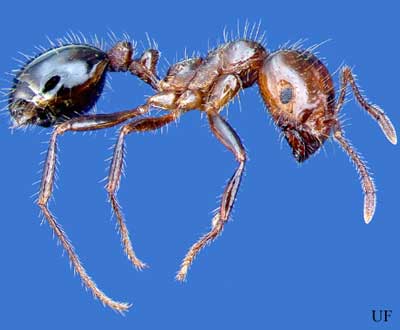
by Rick O'Connor | Dec 2, 2021
Six Rivers “Dirty Dozen” Invasive Species
Red Fire Ant (Solenopis invicta)

The red imported fire ant.
Photo: University of Florida Entomology and Nematology
Define Invasive Species: must have all of the following –
- Is non-native to the area, in our case northwest Florida
- Introduced by humans, whether intentional or accidental
- Causing either an environmental or economic problem, possibly both
Define “Dirty Dozen” Species:
These are species that are well established within the CISMA and are considered, by members of the CISMA, to be one of the top 12 worst problems in our area.
Native Range:
The red fire ant is a native of central South America.
Introduction:
It is believed the first red fire ants entered the U.S. from Brazil into either Mobile AL or Pensacola FL between 1933 and 1945 via ship. As of 2008 they had been reported in 16 states stretching from the east to the west coast, albeit mostly southern states.
EDDMapS currently list 799 records of red fire ants in the U.S. This is certainly well under reported. Most of these are from the southeastern United States (including Texas) and three records from the Washington/Oregon area. There are only 15 records from Florida, 6 from the panhandle, and no records within the Six Rivers CISMA. Again, this is significantly underreported to EDDMapS. It is a well-known species in our area.
Description:
The body of the red imported fire ant is red brown in color with a black gaster (tail). The thin/skinny “waist” has two segments. The mounds are usually of soil and, if disturbed, aggressively defended by the colony. They like well-manicured lawns and in Florida’s sandy soils, may not form the large mounds found in clay-based soils. They differ from the native fire ant (Solenopsis geminate) in that workers of the native species have enlarged square heads – not found in the invasive red imported fire ant.
Issues and Impacts:
The red imported fire ant has become a pest for agriculture and urban communities alike. They can cause both medical and environmental harm.
In agriculture the ant is known to infest soybean fields. Large infestations can lower crop yield, and some states report large infestations impacting the ability to use combines for harvest, reducing yield. One paper reported $156 million in losses with the soybean industry. The ants will feed on the young developing plants of not only soybean but okra, cabbage, citrus, corn, bean, cucumber, eggplant, potato, sweet potato, peanut, sorghum, and sunflower crops. They are also a pest for livestock.
In urban communities they will nest almost anywhere including sidewalks, lawns, driveways, mailboxes, along the sides of homes. During heavy rains they will seek higher ground sometimes entering houses and forming floating mats of live ants that have been problems after storm events. The sting is quite painful. Ants will both bite with their mandibles and inject a venom with a spine on their gaster. The venom is an alkaloid mixture that exhibits potent necrotoxic activity (destroys tissue). The reactions to fire ant stings vary depending on the individual from mild pain to anaphylactic shock. The actual medical cost from the fire ant invasion is unknown. Not only do they sting humans, but pets as well. Fire ants have been found in electrical systems and have caused short circuiting.
These ants have had an impact on native wildlife as well. Ground nesting birds and rodents will cease in areas where the ants colonize, and it is known that they have impacted the protected gopher tortoise populations.
Management:
There are two plans of attack on fire ant management but no long term effective method is known. (1) individual mounds, (2) wide area broadcast application.
Individual Mound
- Liquids poured over the mound can be effective. These liquids can be hot water or insecticide products mixed with water. There are numerous fire ant insecticides available. However, if the queen is not killed (living deep in the mound), recolonization is probable.
- Dusting involves sprinkling an insecticide dust over the mound, and then watering it in.
- Mound injections is an option. Here tools are used to inject the insecticide into the mound. This can be more expensive and hazardous to the handler.
- Baits can be placed on the mound where the colony spreads it through out. This can be very effective but slow going.
- There are certain mechanical and electrical devices on the market, but their efficacy is not well tested.
Some suggest that only 20% of a colony is feeding at any one time and that many insecticides are not as effective. The timing of the control is important. Comprehensive fire ant management information can be found in the Extension publication, Managing Imported Fire Ants in Urban Areas.
Broadcast Applications
Most of the broadcast sprays involve baits or dust products. They can be effective but are often sprayed in locations where the ants cannot find them or become inactive by the time they do.
Biological Control
Biological controls using native predators must be tested to assure they do not have a negative impact on the native flora and fauna. Two potential biological controls, a protozoan and a fungus, are currently being tested along with others.
Phorid flies (which are parasites on fire ants) have been released in the southeast U.S. by the USDA. These colonies of flies have expanded beyond the area where they were released.
Home Remedies
Home remedies including club soda, grits, soap, wood ashes, and shoveling mounds together have shown to be ineffective.
For more information on this Dirty Dozen species, contact your local extension office.
References
Red Imported Fire Ant. Solenopsis invicta. Featured Creatures. University of Florida Entomology and Nematology. https://entnemdept.ufl.edu/creatures/urban/ants/red_imported_fire_ant.htm.
Fire Ants. University of Florida IFAS Gardening Solutions. https://gardeningsolutions.ifas.ufl.edu/care/pests-and-diseases/pests/fire-ants.html.
Fire Ants in Florida. University of Florida Blogs. https://sfyl.ifas.ufl.edu/lawn-and-garden/fire-ants-in-florida/.
Early Detection and Distribution Mapping System (EDDMapS)
https://www.eddmaps.org/
Six Rivers CISMA
https://www.floridainvasives.org/sixrivers/
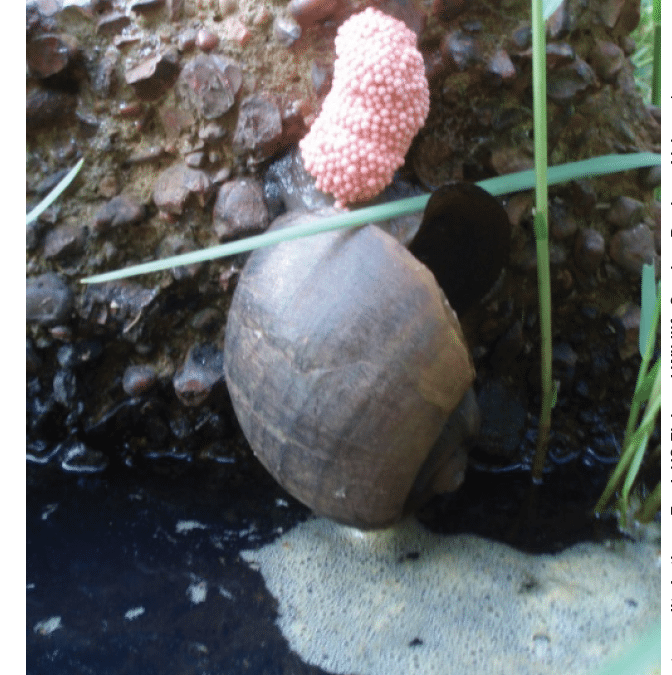
by Rick O'Connor | Dec 2, 2021
EDRR Invasive Species
Apple Snails (Pomace sp.)
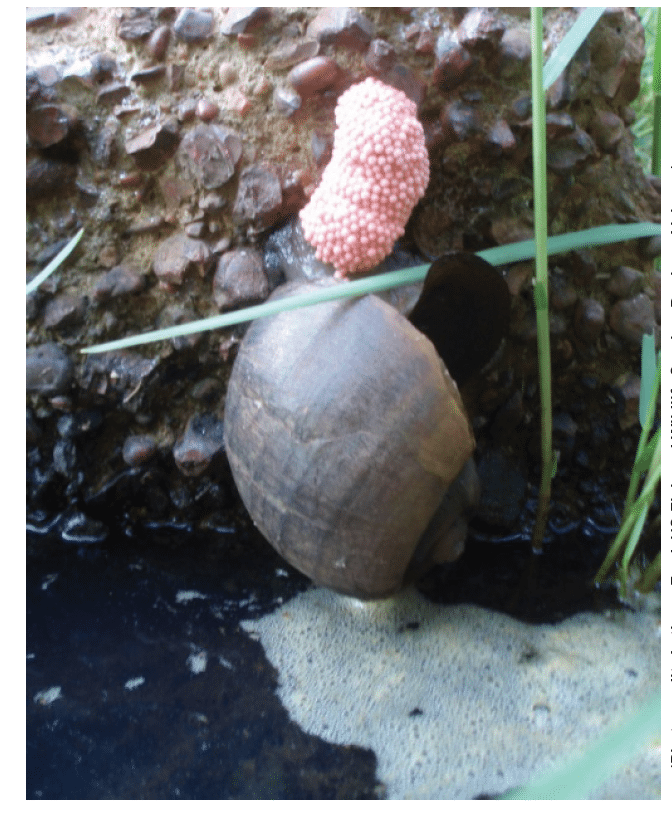
The Apple Snail
Photo: Alabama Cooperative Extension
Define Invasive Species: must have all of the following –
- Is non-native to the area, in our case northwest Florida
- Introduced by humans, whether intentional or accidental
- Causing either an environmental or economic problem, possibly both
Define EDRR Species: Early Detection Rapid Response. These are species that are either –
- Not currently in the area, in our case the Six Rivers CISMA, but a potential threat
- In the area but in small numbers and could be eradicated
Native Range:
There are four species of apple snails in Florida. One, the Florida Apple snail (Pomacea paludosa) is native to the state – thus not invasive.
The island apple snail (P. maculata) is from South America and has been problematic.
The spiked-topped apple snail (P. diffusa) is from Brazil and has not been reported to have caused problems.
The channeled apple snail (P. canaliculata) is from South American and has been very problematic for farmers. It is considered one of the top 100 invasive species problems in the U.S.
Introduction:
There are records of some species being introduced as early as the 1950s as part of the pet trade – particularly for aquariums.
EDDMapS currently list 971 records of all apple snail species. The distribution map indicates they are concentrated in the southeastern United States, though some report the channeled apple snail in Hawaii and California. 30 of those records are in the Florida panhandle and 1 within the Six Rivers CISMA.
There are 579 records of the island apple snail. All are from the Florida, 62 from the panhandle, and 1 from the Six Rivers CISMA.
There are 27 records of the highly invasive channeled apple snail. All 27 are from Florida, 18 are from the Jacksonville area but there are two records from the panhandle, and both are from Panama City.
There are 24 records of the spiked-top apple snail. All are from Florida, and all are from the peninsula part of the state. There are no records in the panhandle.
There are 6 records of the Titian apple snail (P. haustrum). All are from the Miami area.
THE ONLY SPECIES REPORTED IN SIX RIVERS IS THE ISLAND APPLE SNAIL – WHICH IS A PROBLEM ONE.
THERE ARE RECORDS OF THE CHANNELED APPLE SNAIL – ONE OF THE WORST INVASIVE SPECIES IN THE U.S. – IN THE PANAMA CITY AREA.
Description:
These are relatively large freshwater snails with round shells that are olive green or brown in color (some are yellow) and have a large aperture (opening) where the snail exposes itself from the shell. The smallest (the native Florida apple snail) may be 2-3 inches in size, but the island apple snail can reach 5 inches. They are not easy to tell apart.
Issues and Impacts:
The issue is the consumption of vegetation. The native Florida apple snail feeds on epiphytes and periphyton that grow on the submerged, and emergent, aquatic plants of the Florida. However, the invasive varieties (island and channeled) feed directly on the vegetation and can be quite destructive of native wetlands and agricultural crops.
Management:
There have been attempts to use chemicals to control the invasive varieties of the apple snails, but with little success. Hand removal is best option now. There are several native animals that have been know to prey on all varieties of apple snails and this has helped. Apple snails attached their eggs to blades and leaves of aquatic and subaquatic plants above the water line. You can scrape these eggs off into the water and they will die. HOWEVER, THE INVASIVE APPLE SNAIL EGGS ARE PINK. THE NATIVE EGGS ARE WHITE – SCRAP ONLY PINK APPLE SNAIL EGGS INTO THE WATER.
DO NOT DISCHARGE UNWANTED AQUARIUM PETS INTO LOCAL WATERWAYS.
For more information on this EDRR species, contact your local extension office.
References
Fasulo, T.R. 2021. Apple Snails of Florida, Pomacea Spp. (Gastropoda: Ampullariidae ). University of Florida IFAS Extension. Electronic Data Information System Document #EENY323. https://edis.ifas.ufl.edu/publication/in598.
Florida Apple Snails. 2021. Shining a Spotlight on Florida’s Apple Snail Populations. Florida Fish and Wildlife Conservation Commission. https://myfwc.com/research/freshwater/species-assessments/mollusks/apple-snails/.
Early Detection and Distribution Mapping System (EDDMapS)
https://www.eddmaps.org/
Six Rivers CISMA
https://www.floridainvasives.org/sixrivers/

by Rick O'Connor | Oct 21, 2021
Six Rivers “Dirty Dozen” Invasive Species
Feral Hog (Sus scrofa)

Wild Hog
Photo: University of Florida
Define Invasive Species: must have all of the following –
- Is non-native to the area, in our case northwest Florida
- Introduced by humans, whether intentional or accidental
- Causing either an environmental or economic problem, possibly both
Define “Dirty Dozen” Species:
These are species that are well established within the CISMA and are considered, by members of the CISMA, to be one of the top 12 worst problems in our area.
Native Range:
The feral hog in Florida today is believed to be the descendants of a hybrid between domestic pigs and wild boars in Europe.
Introduction:
These animals were introduced by the Spanish colonists during the 1500s. It is known that Ponce de Leon brought pigs with him in 1521 but it is not known what happened when this expedition failed. It is known that in 1539, Hernando de Soto did bring European pigs and began raising them using the free-range method. The term “feral” refers to domesticated animals that escaped and now live as “wild” animals. The term “feral hogs” is used for both the original European releases and any domesticated hogs that may have escaped.
It is now believed that there are breeding pairs of “wild pigs/feral hogs” in 39 states. Population estimates in the Florida are believed to be greater than 500,000. Most are west and north of Lake Okeechobee.
EDDMapS currently list 6,666 records of feral hogs in the U.S. This is certainly under reported. There are 243 records from Florida, 45 of those in the panhandle, and 26 within the Six Rivers CISMA. Again, this is significantly underreported to EDDMapS.
Description:
Feral hogs are usually brown, black, or brindle in color, juveniles may have stripes. They can reach five to six feet in length and weigh up to 250 pounds.
Issues and Impacts:
The primary issue with feral hogs in their rooting behavior. These animals will destroy a lot of habitat rooting under the soil with their snouts and hooves looking for roots, tubers, and fungus to eat. They destroy native vegetation, some of which are protected species, as well as altering the soil chemistry completely changing the environment. They are also known to carry disease that can be transmitted to livestock and, in some cases, to humans. It has been estimated that feral hogs cause over $2 billion in damage to agricultural products annually.
They also love acorns and compete heavily with local deer and turkey populations for this food source, impacting those populations. They are known nest raiders and impact the nesting of native turtles and ground nesting birds. They are not beyond grabbing small livestock from local farms.
Management:
On private land, feral hogs are considered livestock and can be removed with owner permission. There are no bag limits or closed seasons when hunting on these lands. On public lands there can be seasons and licenses/permits required. Hunting, trapping, and exclusion are all methods being used. Methods of trapping include cages. The types, and effectiveness, are addressed in the UF IFAS EDIS publication UW3222. Exclusion usually involves fencing and the best methods are also explained in UF IFAS EDIS UW322. However, hogs are intelligent animals and often find ways around fences. Trapping is considered the most effective method.
For more information on this Dirty Dozen species, contact your local extension office.
References
1 Boughton R.K., B. Wight. 2021. Wildlife of Florida Fact Sheet: Feral Swine. University of Florida IFAS. https://edis.ifas.ufl.edu/publication/UW442.
2 Giulianio W.M. 2021. Wild Hogs in Florida: Ecology and Management. University of Florida IFAS. https://edis.ifas.ufl.edu/publication/UW322.
Early Detection and Distribution Mapping System (EDDMapS)
https://www.eddmaps.org/
Six Rivers CISMA
https://www.floridainvasives.org/sixrivers/
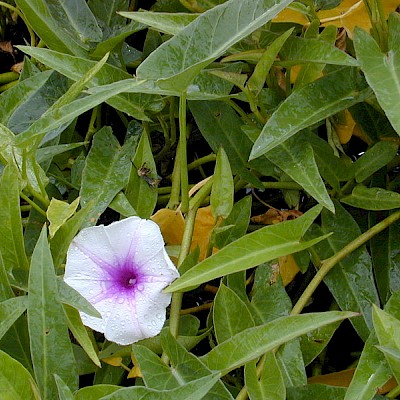
by Rick O'Connor | Oct 6, 2021
EDRR Invasive Species
Swamp Morning Glory – Water Spinach (Ipomoea aquatica)

Swamp Morning Glory (also known as Water Spinach)
Photo: University of Florida IFAS Center for Aquatic and Invasive Plants
Define Invasive Species: must have ALL of the following –
- Is non-native to the area, in our case northwest Florida
- Introduced by humans, whether intentional or accidental
- Causing either an environmental or economic problem, possibly both
Define EDRR Species: Early Detection Rapid Response. These are species that are either –
- Not currently in the area, in our case the Six Rivers CISMA, but a potential threat
- In the area but in small numbers and could be eradicated
Native Range:
Swamp Morning Glory, also known as Water Spinach, is native to the East Indies.
Introduction:
The plant was cultivated in many southeast Asian countries during World War II and was known as “water spinach”. It was later brought to the U.S. and cultivated in California, Florida, Hawaii, Texas, and Arizona. It escaped cultivation.
EDDMapS currently list 48 records of Swamp Morning Glory in the U.S. Three are in northern California, one in Texas, and the remaining 44 are from Florida. Two of those in Florida are from the panhandle in Walton County near Miramar Beach and are within the Six Rivers CISMA.
Description:
The plant appears as a trailing herbaceous vine in aquatic systems and produces a milky sap. The leaves are alternate and simple. The blades are arrowhead shaped but can vary. They usually end in a point and are about 7 inches long. They are held above the water most of the time.
The flowers are pretty and showy being funnel shaped. They are white to pink in color.
Issues and Impacts:
This plant forms dense mats at the surface blocking needed sunlight to submerged species. The vines can grow over 70 feet in length and can present problems with flood control. It also competes with native emergent plants for space and resources.
Management:
Aquatic herbicides have been used but only with temporary relief. Diuron provided satisfactory control on plants growing in dry ditches but was nonselective and killed other nearby plants. Paraquat, glyphosate, and 2,4-D have been shown to have control over growth of the plant but are also nonselective and will kill other plants it comes in contact with.
For more information on this EDRR species, contact your local extension office.
References
Global Invasive Species Database. Ipomoea aquatica. http://issg.org/database/species/management_info.asp?si=477&fr=1&sts=&lang=EN.
Ipomoea aquatica. 2021. Wikipedia. https://en.wikipedia.org/wiki/Ipomoea_aquatica.
Water Spinach (Ipomoea aquatica). 2021. Center for Invasive Species and Ecosystem Health. https://plants.ifas.ufl.edu/plant-directory/ipomoea-aquatica/.
Water Spinach. Florida Fish and Wildlife Conservation Commission. https://myfwc.com/wildlifehabitats/habitat/invasive-plants/weed-alerts/water-spinach/.
Early Detection and Distribution Mapping System (EDDMapS)
https://www.eddmaps.org/
Six Rivers CISMA
https://www.floridainvasives.org/sixrivers/
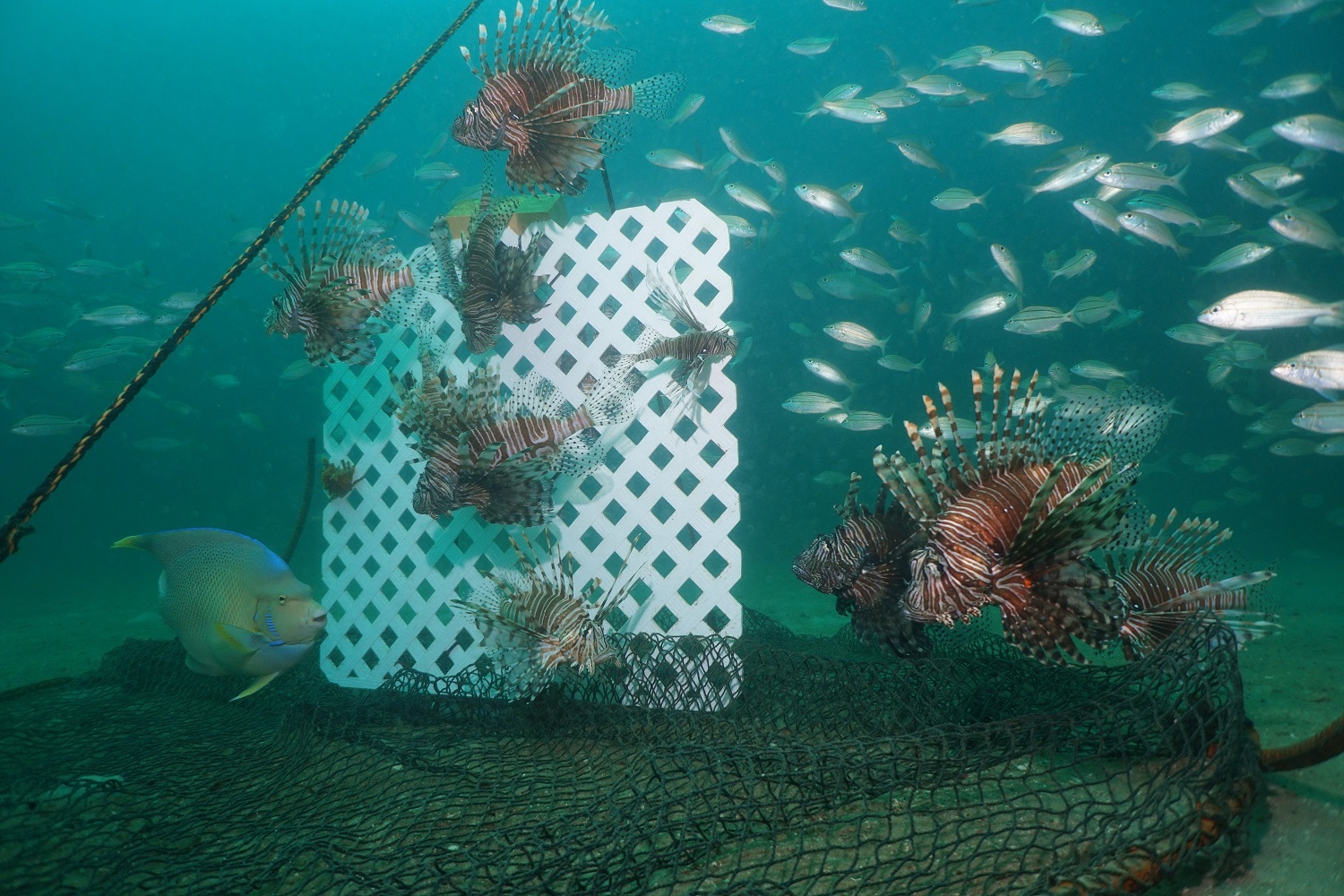
by Rick O'Connor | Sep 15, 2021
Six Rivers “Dirty Dozen” Invasive Species
Red Lionfish (Pterois volitans)

Lionfish in tank. Photo credit: Laura Tiu
Define Invasive Species: must have all of the following –
- Is non-native to the area, in our case northwest Florida
- Introduced by humans, whether intentional or accidental
- Causing either an environmental or economic problem, possibly both
Define “Dirty Dozen” Species:
These are species that are well established within the CISMA and are considered, by members of the CISMA, to be one of the top 12 worst problems in our area.
Native Range:
The Indo-Pacific and Red Sea.
Introduction:
The first record of lionfish in U.S. waters was in the late 1980s off the coast of Davie, Florida. It is believed the release was connected to the aquarium trade but whether it was accidental or intentional is unknown.
EDDMapS currently list 3,029 records of lionfish in the U.S. This is certainly under reported. Few invasive marine fish are reported to EDDMapS. Most are reported to a NOAA website which reports area of lionfish rather than individual records. It is known that the lionfish is well established all along the eastern seaboard of the United States, Bermuda, the Caribbean, and the entire Gulf of Mexico – including the coastal areas of Six Rivers CISMA. In 2014, it was reported that the densities of lionfish off the Six Rivers CISMA were some of the highest in the entire south Atlantic Region1. At a regional workshop in 2018, it was reported these densities had declined in waters less than 200 feet2.
Description:
Lionfish are deep bodied fish with large dorsal and pectoral fins and a truncate caudal fin. It is a slow swimmer. The body has a white/maroon vertically striped pattern that includes the head. The dorsal spines extend above tissue of the dorsal fin and possess a neurotoxin that is quite painful. The enlarged pectoral fins resemble wings and are used by the fish to corral prey into corners. There are no venomous spines on the pectoral fins but there are on the pelvic and anal ones. Lionfish have a large gaping mouth that can swallow a variety of prey using an engulfing/vacuum method.
Issues and Impacts:
These are voracious predators and have been known to consume over 70 different species of small demersal reef fishes. These small fish play an important ecological role on the reefs they inhabit, such as prey for larger commercially sought-after fish species as well as those that graze algae and keep the corals from being smothered by such. The decline of these populations can have both ecological and economic impacts. Studies have found that the popular red snapper will stay further away from reefs inhabited by lionfish, and they are also known to inhabit lobster traps in the Florida Keys, impeding the entry of the much sought-after spiny lobster.
Management:
The high reproductive rate has made lionfish management difficult. Adult females are known to produce an average of 30,000 fertilized every four days. The fertilized eggs are encased in a gelatinous sac that drifts with the currents and disperses the young to new territories. There are toxins associated with this sac and consumption of larvae is not currently known. In addition to high reproductive rates, the currents disperse the developing young great distances and lionfish are known to tolerate salinities found in estuaries.
They rarely bite hook and line making the most effective of removal being the diver with a pole spear. There are very good lionfish hunters, and prize-winning tournaments are well attended, but studies have shown that removals using spear must be repeated about once a month to be effective. Effective here meaning keeping the population stable, lionfish is a “Dirty Dozen” species, it will not be eradicated.
Test using traps are currently being conducted and these may prove to be more effective than removing by spear alone. There are a few native species that have been known to consume lionfish, but not at a rate to impact their invasion. Since 2018 lionfish in the south Atlantic region have been reported with skin lesions. It is not known at this time how this will impact their numbers, but early studies suggest it is.
For more information on this Dirty Dozen species, contact your local extension office.
References
Early Detection and Distribution Mapping System (EDDMapS)
https://www.eddmaps.org/
Six Rivers CISMA
https://www.floridainvasives.org/sixrivers/

by Laura Tiu | Sep 9, 2021
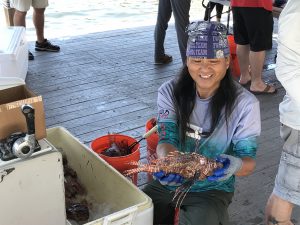
A Lionfish Removal and Awareness Day festival volunteer sorts lionfish for weighing. (L. Tiu)
The northwest Florida area has been identified as having the highest concentration of invasive lionfish in the world. Lionfish pose a significant threat to our native wildlife and habitat with spearfishing the primary means of control. Lionfish tournaments are one way to increase harvest of these invaders and help keep populations down. Not only that, but lionfish are a delicious tasting fish and tournaments help supply the local seafood markets with this unique offering.
Since 2019, Destin, Florida has been the site of the Emerald Coast Open (ECO), the largest lionfish tournament in the world, hosted by Destin-Fort Walton Beach and the Florida Fish and Wildlife Commission (FWC). While the tournament was canceled in 2020, due to the pandemic, the 2021 tournament and the Lionfish Removal and Awareness Day festival returned to the Destin Harbor May 14-16 with over 145 tournament participants from around Florida, the US, and even Canada. The windy weekend facilitated some sporty conditions keeping boats and teams from maximizing their time on the water, but ultimately 2,505 lionfish were removed during the pre-tournament and 7,745 lionfish were removed during the two-day event for a total of 10,250 invasive lionfish removed. Florida Sea Grant and FWC recruited over 50 volunteers from organizations such as Reef Environmental Education Foundation, Navarre Beach Marine Science Station and Tampa Bay Watch Discovery Center to man the tournament and surrounding festival.
Lionfish hunters competed for over $48,000 in cash prizes and $25,000 in gear prizes. Florida Man, a Destin-based dive charter on the DreadKnot, won $10,000 for harvesting the most lionfish, 1,371, in 2 days. Team Bottom Time secured the largest lionfish prize of $5,000 with a 17.32 inch fish. Team Into the Clouds wrapped up the $5,000 prize for smallest lionfish with a 1.61 inch fish, the smallest lionfish caught in Emerald Coast Open History.
It is never too early to start preparing for the 2022 tournament. For more information, visit EmeraldCoastOpen.com or Facebook.com/EmeraldCoastOpen. For information about Lionfish Removal and Awareness Day, visit FWCReefRangers.com
“An Equal Opportunity Institution”










